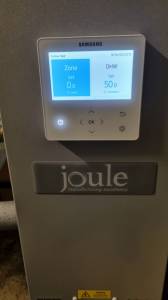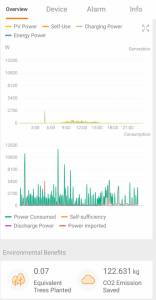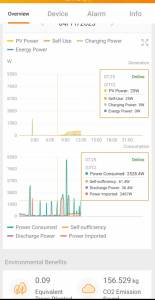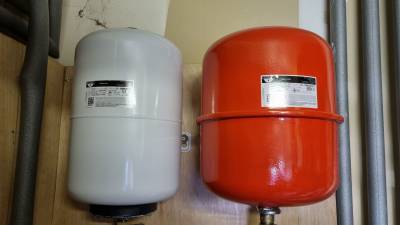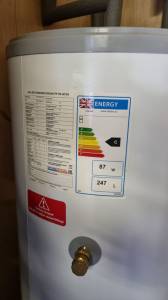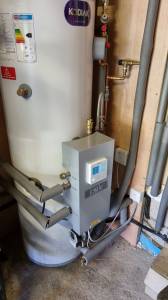New installation not quite right, advice sought
I have joined the forum after reading many informative posts. We are basically at the point where I need advice about
what to do next. In summary:
1) What can I do next to optimise efficiency?
2) Would it make sense to just run the hot water tank heating once a day, say 3 to 5pm or so?
3) What has worked for people in terms of reducing noise around the heat pump? It is loudest when running at top speed and output and I hope to reduce that so it should get quieter anyway
4) Is there anyone in central Scotland who does yearly servicing of heat pumps and their hot water tanks?
The long bit:
We have a 4 bedroom detached 2000 built timber frame house, formerly heated with oil. The boiler was 23 years old and
we could see it would need replacement at some point and the system had some slow water leaks, one of which I found
and fixed but there seemed to be others. Wanting to get something modern and reduce our carbon footprint, we reckoned
a heat pump would be the thing and the space in the garage occupied by the boiler could be filled with the hot water
tank.
We also wanted to use local traders more than contacting folk many miles away and having them travel etc. Being in
central Scotland we could also get a grant and a 0% loan for solar panels and battery and heat pump. Therefore we
looked through the MCS website for possible companies to quote for us and got 3. (I won't bring the panels and
battery installation into this, it seems to be fine)
I eliminated one which was going to use a heat pump that had lots of bad reports online about it. Overall the quotes
seemed to be fairly similar, making similar estimates of heat requirements (We had 18 months of oil purchase reciepts
so could be fairly accurate, but of course it varies wildly winter to winter).
On the other hand one quoted for a 9kW HP, the others 12kW. Last winter we had 3 nights of -15C and it can hover
around zero for a week; we wanted a heat pump that could deal with low temps and given the way winter can go, a quote
which recognised that while our mean temp was 9C, the average cold temp was more like -4.9 seemed sensible.
It seems likely to me now that everyone was using similar MCS approved models for such calculations.
My first mistake was in letting my partner do the actual talking to sales people since I was at work early this year
and she was not. Not being technical minded she didn't ask any relevant questions. Then when it came to decide which
quote to go for, I did not have the mental headspace to interrogate them properly due to various things which were
going on in life.
And anyway, how far wrong can a properly approved installer with experience go?
The answer is, quite far.
We ended up with a Samsung 12kW heat pump, 6th gen so nice and new, tied into a Joule hot water tank and new
radiators. I think all the quotes had specified that we needed new radiators, which made sense given the house was
built cheaply and with the worst radiators they could get away with, fine for oil heating and 60C or higher water, not
much use for anything else. We also usually want the house at 18C, not the 21C that everyone seems to use in their
models, which I reckoned increased the chance the heat pump was overspecified but on the other hand given how winter
can be around here...
It was all installed and plumbed in last month, the workers did a decent job, tidied up after themselves and gave the
impression they did this a lot. Pipes lagged, everything laid out clearly and accessible to my non plumbing mind. We were left with the manuals and an expectation that there would be the usual MCS paperwork, some of which did eventually arrive last week. I checked and it seems that if there were any problems we
should contact the office. The pump was running when I got home from work and the house warming up, with a dumb
Honeywell thermostat in the kitchen and the house was warming up nicely, so we were happy to start with.
I have attached a photo of the Samsung control unit on the water tank.
Now, the solar panels and battery had gone in the week before and proved that they worked fine. There is an app with
the inverter which tracks electricity use and transfer, so I was able to confirm that we used roughtly 10kWhr a day,
which I had previously estimated from meter readings.
The app also gave nice pictures and graphs and since I had been reading up on heat pumps the last week in anticipation
of seeing how well our installation went, I was on the lookout for cycling. At this point in time the weather was
reaching 13 or 14C in the day and 6 to 10 at night, a warmer October than usual. So cycling might be expected, but as
you can see in this picture, it was surprisingly regular. The heat pump never seemed to switch on for long.
This bugged me and I spent more time reading up on it as well as monitoring performance. We seemed to need 15 to
23kWhr more per day to run the heat pump than before it was intalled usual, which given the claimed efficiency of it,
did seem a bit high, making rough comparison with the amount of heating oil required for similar weather days
previously.
Eventually I was looking at the thermostat quick start installation guide and found that it had something called a
cycle rate. But before fiddling with that I put in a setback of 18 to 16C for 7hrs at night and about 5 in the middle
of the day. I left that for a couple of days but still noticed quick cycling after the initial cooldown but we did
seem to use a little less energy.
So I went to the cycle rate and it was set to 5, which after much checking turned out to be the midpoint, options
being 1 to 10, of how many times it could switch on per hour if the temperature got too low.
You will be unsurprised to learn that once I turned the cycle rate down to 1, the 5 times per hour cycling stopped and
it began turning on for longer, up to half an hour then turning off. But mostly 20 mins was enough to reach the
desired temperature again, earlier this month, and it would turn on again after an hour due to heat loss in the house.
You can see from this picture that it worked quite well and unsurprisingly our electricity use dropped by 5 or 6 kWhrs
per day, giving an idea of just how much was being wasted by this setting.
However this leaves us with an issue. Now we have had some nights of -2C or similar, you can see that it has trouble
running long enough to get the house back up to temperature and it is clear that a dumb controller with a simple on
off capability is useless for running a heat pump properly.
I have been reading various useful and interesting posts and as far as I can see it is possible to run it more
efficiently, at a lower power for longer, but the question is how. All I have is the Honeywell controller and the
native Samsung control, which is stuck in the garage. If we need a better controller that is fine, we can get one
installed or possibly I could have a go as long as it is simple enough to attach a few wires. The issue is, which
one? I am also quite happy fiddling with the weather curve, which at the moment seems to be set at +15 one end and +2
at the other, which is odd. I will get figures for the next post.
I will also put some more photographs of the installation up later. There is glycol in it, which seems standard
practise, and a small balancer or whatever tank, which most likely is unnecessary, but the main lesson here is that
too many companies install heat pumps like they do gas boilers and treat them the same way, even although they are
not.
The other questions at the top should be clear enough. The pump is situated as specified, but because we are in the
countryside it is very loud at times, even if within actual specification. I think this is partly because it is
working much harder than it might otherwise have to because it is dealing with being on for a short time.
I also see from the MCS website that a handover pack is supposed to be supplied with the heat calculations for each
heated room, , the maintenance requirements, installation and operating manuals (Which we have at least) and some
other stuff, but we don't seem to have all of that yet.
I plan next week to ask the installer annoying questions like how to stop the system cycling 5 times an hour and see
what they say. It is also a fact that Joule hot water tanks have QC issues, there are too many posts on the internet
saying that Joule did not take an interest in fixing broken ones for me to rest easily.
Here are photos of the hot water tank, the two tanks above it and the label of the tank itself. The system does seem fairly straightforwards, but I am not 100% what the tanks do, at least one is I think for adding glycol or something to do with treating the tank. The Samsung controller for the heat pump is on the tank on a Joule control box and to the right at the back on the wall you can see the Honeywell wireless unit, which is wired into the Joule controlling unit. Basically they have bought everything off the shelf and connected it all together, which is the way to go if you want quick efficient heat pump installations. Not so good if you then leave with it badly set up.
The red and white vessels will be expansion tanks, one for the heat pump water circuit and the other fro the Domestic Hot Water (DHW).
To stop forced cycling and improve efficiency it may be possible to have the samsung controller moved from its present position in your garage to a suitable location indoors. This should then be used to control the heat pump not the honeywell thermostat.
In the meantime can the honeywell be set for zero cycling, just on - off control?
The Weather Compensation (WC) should have settings along the lines 50C @ -3C to 30C @ 15C. This setting should produce a Leaving Water Temperature (LWT) of 50C when the Outside Air Temperature (OAT) is -3C and below, reducing the LWT as the OAT increases until at an OAT of 15C and above the LWT should be 30C.
Obviously the WC curve will need to be adjusted to match the heat loss characteristics of your home, but the above settings may not be a bad starting point.
Maximum overall efficiency may be achieved when the heat pump is maintaining the Indoor Air Temperature (IAT) using the lowest LWT that meets demand.
When the WC curve is correctly adjusted, the honeywell thermostat should be set at 1C above the desired IAT, to act as an over temperature limiter.
Posted by: @derek-mThe red and white vessels will be expansion tanks, one for the heat pump water circuit and the other fro the Domestic Hot Water (DHW).
To stop forced cycling and improve efficiency it may be possible to have the samsung controller moved from its present position in your garage to a suitable location indoors. This should then be used to control the heat pump not the honeywell thermostat.
In the meantime can the honeywell be set for zero cycling, just on - off control?
The Weather Compensation (WC) should have settings along the lines 50C @ -3C to 30C @ 15C. This setting should produce a Leaving Water Temperature (LWT) of 50C when the Outside Air Temperature (OAT) is -3C and below, reducing the LWT as the OAT increases until at an OAT of 15C and above the LWT should be 30C.
Obviously the WC curve will need to be adjusted to match the heat loss characteristics of your home, but the above settings may not be a bad starting point.
Maximum overall efficiency may be achieved when the heat pump is maintaining the Indoor Air Temperature (IAT) using the lowest LWT that meets demand.
When the WC curve is correctly adjusted, the honeywell thermostat should be set at 1C above the desired IAT, to act as an over temperature limiter.
Oh good, the installation isn't quite as bad as I thought it might be, expansion tanks are less serious than buffer ones.
The thermostat didn't seem to want to go lower than 1 cycle per hour, I can look again. As for moving the Samsung, that would require it be dismounted from the Joule box in some way, which would need someone who knows what they are doing. I have some experience of fiddling about with wires and controllers, but moving the whole thing several metres through a wall starts to get messy.
I have seen other explanations of what you suggest re. the thermostat elsewhere; I am having trouble seeing how it works, words don't always map well onto concepts. But an attempt is, if the remote thermostat is set higher than desired, it means the heat pump should always be on. Then, when it is on all the time, with the WC adjusted, the heat pump will run continuously at at low rate, increasing the temperature of the flow water when it gets colder outside and lowering it when it isn't. What I don't get is how well it can be balanced so that it hovers around the desired temp (18C ideally with some setback at night) without getting too high, what is stopping that?
I saw elsewhere on the forum you can change some settings on the Samsung controller to get weekly cycles of some kind.
Posted by: @guthrieI have seen other explanations of what you suggest re. the thermostat elsewhere; I am having trouble seeing how it works, words don't always map well onto concepts. But an attempt is, if the remote thermostat is set higher than desired, it means the heat pump should always be on. Then, when it is on all the time, with the WC adjusted, the heat pump will run continuously at at low rate, increasing the temperature of the flow water when it gets colder outside and lowering it when it isn't. What I don't get is how well it can be balanced so that it hovers around the desired temp (18C ideally with some setback at night) without getting too high, what is stopping that?
Hi, you are right to say that the best way to use your thermostat is to set it much higher than desired room temperature. This allows the heat pump to run continuously and be most efficient. You can then have a setback at night by setting the thermostat to say 14 degC at 10.30pm. This will switch the heat pump off and the house will cool until say 4am when you time your thermostat to call for heat again with a setting of 25degC. If you have done your water law settings correctly, then the house will be close to 18degC after some hours. As the house warms the difference between radiator temperature and room temperature falls, so less heat is given out by the radiators. This feeds back to the heat pump which reduces its consumption and heat outout. You will know when you are getting close to a steady state when the consumption stops falling from an originally higher level and the room temperature rise gets slower. If the room temperature is higher than you want, then you can adjust the water law (weather compensation) and therefore the LWT, very simply. On the Samsung controller, you can adjust the offset from 0 up to +5 and down to -5. This moves the weather compensation line to the right or left.
If you run the pump continuously from 7am till 10.30pm with a more or less constant room temperature, then you will be using the lowest LWT possible for your set up. However, with this LWT, you will find it takes a long time to recover after a 5 hour setback. The solution to this is to increase the offset before you go to bed and return it to its previous setting when you get up. In other words, there is a maintenance LWT and a higher recovery LWT. Both of these will vary with outside temperature, but the recovery LWT will always be greater. By experimenting with different offsets I found that a Water Law setting of 40degC at OAT of 0 and 20degC at OAT of 20 is just sufficient to warm the house to 17.5-18 degC by 7am after 3 hours of running. The house then cools again until the ASHP comes on again between 1pm and 4pm. Essentially, I have several setbacks and recoveries, which is usually frowned upon by the purists. My COP would be higher if I left it on all the time, but my consumption is lower and if I am out most of the morning, I don't mind the house being cooler then. We also cheat in the evening with a log burner!
I know that some controllers can be removed from their main housing and relocated using a suitable extension cable, but I'm not certain if this can be done with the samsung, otherwise they may provide a wireless room sensor which can be added. Have a read through the manual for optional extras.
You adjust the WC settings to balance the IAT at the desired value, raising the curve will increase the IAT and vice versa. It can take quite some time to get the WC curve correctly adjusted.
The required LWT (set by the WC curve) regulates how much thermal energy the heat emitters actually emit. Similar to driving a car, pushing the pedal so far down will increase the speed until it balances at a certain point.
I believe that there are various schedules that can be set within the controller. Maybe a samsung owner can provide better advice.
Posted by: @guthrieI saw elsewhere on the forum you can change some settings on the Samsung controller to get weekly cycles of some kind
You can only use the weekly schedule if you are using the Samsung controller as your thermostat instead of a third party thermostat. You can't do this at present due to the location of your controller.
Posted by: @guthrie@mike-h Exactly, that's the bind we are in just now.
I don’t think you should be too bothered about that. If you use your existing thermostat just for a night time setback ie make it turn the ASHP off for a few hours overnight and otherwise set it to a much higher temperature than desired room temperature, you should find the weather compensation works well.
Others may have a different experience , but I expected the Samsung controller thermostat would make the heat pump modulate down as room temperature approached set temperature. However, it didn’t seem to do so and consumption stayed constant up until the point that it switched the heat pump off. Therefore it appeared to operate exactly the same as my third party thermostat. The latter is so much easier to schedule, so I have continued to use it.
@mike-h - the key thing is that standard weather compensation for most heat pumps only takes account of the outside air temperature, and sets the LWT based on that outside air temperature: if it is cold outside, supply more heat, if it is warm outside, supply less heat. These heat pumps - the vast majority - do not take into account indoor air temperature, which may well be higher than intended - for example, because of solar gain, meaning the LWT needs to be lowered a bit - or lower than intended - for example, because of a recent setback, meaning the LWT needs to be increased a bit. Only one manufacturer that I know of, Mitsubishi, provides an optional way of dealing this, by way of their so called Auto Adaption. For the rest of, we need some sort of third party solution. One option is Homely; another, for those who have a modbus enabled heat pump (many are, including Samsung with an add-on) is to set up a DIY auto adaption system using a small PC and some python code. You do need some basic computing knowledge and skills (eg you know what a variable is, and are familiar with concepts like if-then-else), but if you have those, it is not complicated. I have covered various aspects of this in other posts on the forum.
Midea 14kW (for now...) ASHP heating both building and DHW
@guthrie Moving the Samsung controller is quite easy, just two wires. This would be suitable to extend it.
https://midsummerwholesale.co.uk/buy/renewable-heat-accessories/cy-2-core-comms-cable
House-2 bed partial stone bungalow, 5kW Samsung Gen 6 ASHP (Self install)
6.9 kWp of PV
5kWh DC coupled battery
Blog: https://thegreeningofrosecottage.weebly.com/
Heatpump Stats: http://heatpumpmonitor.org/system/view?id=60
@guthrie This is the link to Glyn Hudson’s video, which includes a description of how to use the weekly space heating schedules.
https://m.youtube.com/watch?v=lYM2jclJvcQ&list=PLfU4EBfUMOvnVTB0WhyqQ23pvt7hnrc54&index=3&pp=iAQB
- 26 Forums
- 2,396 Topics
- 54.3 K Posts
- 319 Online
- 6,077 Members
Join Us!
Worth Watching
Latest Posts
-
RE: Vaillant aroTherm not heating with many faults
@anon67 Well its just a few things you can check that r...
By ASHP-BOBBA , 24 seconds ago
-

RE: RDSAP10 effect on existing heat pump EPC rating?
…as in Jack?
By Majordennisbloodnok , 9 minutes ago
-
RE: Predicted Heat Loss & Needs from MCS calcs vs EPC vs actual
COP of 3 perhaps a little low and you say that you don'...
By benson , 21 minutes ago
-
RE: Heatpunk Floor plan issues
@jamiejones85 A2A they will design on dynamic heat loss...
By ASHP-BOBBA , 36 minutes ago
-
RE: Considering MLCP (Multi-Layer Composite Pipe) for ASHP
I think the concern was about crud being forced from th...
By iotum , 37 minutes ago
-

RE: Recommended home battery inverters + regulatory matters - help requested
The usual type of underground cable with a metal 'outer...
By Transparent , 41 minutes ago
-
RE: Rate the quality of your heat pump design and installation
Welcome to the forum and I am sorry you are disappointe...
By JamesPa , 45 minutes ago
-
RE: Fan unit Making terrible noise HELP!!
can you post a video looking inside, at and through the...
By ASHP-BOBBA , 1 hour ago
-

RE: Setback savings - fact or fiction?
Excellent graphics and description Rob…. But to my mind...
By SUNandAIR , 2 hours ago
-
RE: Heat pump not reaching flow temperature
@davec Ive had a look at the screenshots. Lots of th...
By JamesPa , 13 hours ago
-

RE: Power outages and storms: A surprisingly good DNO experience
Agreed, which is no more nor less than a customer shoul...
By Majordennisbloodnok , 18 hours ago
-

RE: Running from backup generaor in powercut?
@batpred In our case, 3 times each day when the Octopus...
By Toodles , 19 hours ago
-
RE: Advice for a novice on Mitsubishi Ecodan 6kW
Hi @sheriff-fatman Cycling at 5C and below is usuall...
By RobS , 19 hours ago
-
RE: New Fogstar 15.5kWh upright solution
@batpred Here's the latest Fogstar ready built pack....
By Bash , 21 hours ago
-
RE: Solis inverters S6-EH1P: pros and cons and battery options
Solis confirmed that the S6 works with a single battery...
By Batpred , 21 hours ago
-
RE: Who has a V2G EV installation
I am wondering if in any V2X, would the car battery eve...
By Batpred , 22 hours ago
-
RE: New Mitsubishi Ecodan 11.2kW installation - L9 errors and maybe more
OK. I think your system, which seems well designed, is...
By JamesPa , 1 day ago
-

RE: Fan is clipping ice build up from the front of unit.
@majordennisbloodnok I’ll not go there thanks! Toodles.
By Toodles , 2 days ago
-
RE: Running my new Nibe ASHP efficiently
I'm new to the forum. Did you get a reply to this last ...
By Mike @ Camelot , 2 days ago

